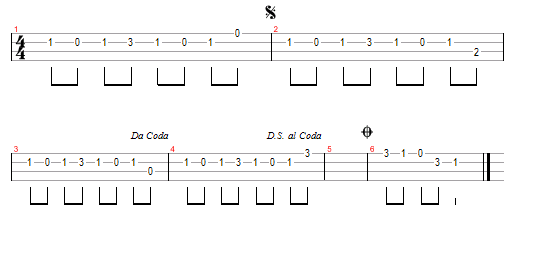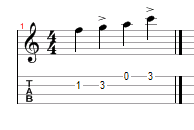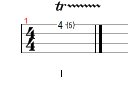Advanced Repeats
There are a vast array of Italian scribblings and scrawlings, and Heroes style symbols that can be used to indicate repeats. Here are the most common.
Whereas the other form of repeats is fairly intuitive, this type is pretty indecipherable (unless you happen to be fluent in Italian).
The first time round, you can breeze past the symbols until you reach D.S. al Coda (short for da signo al coda). It means you have to go back to the strange looking squiggle (at the beginning of bar two) then you play through until you reach Da Coda. At this point you go to the little target symbol.
In this example you’ll play bars:
1, 2, 3, 4, 2, 3, 6.
It is possible to get all sorts of double signos and double codas, but you’ll probably never see these in ukulele tab. The only variation you might find is D.C. al Coda rather than D.S. al Coda. This means you go back to the start rather than going back to the sign.
Don’t worry if you didn’t get all of that. I still have to double check when I come up against this sort of repeat.
Accents
You accent notes by giving them an extra little oomph. This might be strumming harder to accentuate a beat or picking a note harder to emphasise the melody.
Accents are shown in tab with an arrow above the note or chord.
This snippet shows an exaggerated example:
Dead Notes
Dead notes are clicks produced by strumming the uke while damping all the strings with your fretting hand. Lay your fingers gently across the strings. You should touch the strings just enough to stop them ringing but not enough to fret the note.
Trills
Trills are produced by repeatedly hammering-on and pulling-off the same two notes. They are shown by the letters tr followed by a wavy line.
In this example, the A string is played at the fourth fret then you hammer-on and pull off at the fifth fret repeatedly.
This series was derived from my ebook Ukulele 101: 101 Things Every Ukulele Player Needs to Know.








You are going much, much faster than I am or can, but I save (and treasure) your lessons. My son and I try to practice 3 – 4 times a week. I have never played an instrument before.
Thanks for the help.